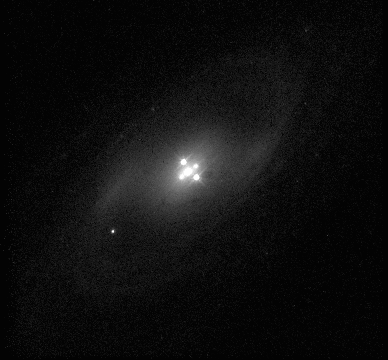
Surely the most spectacular of the 12 or so well-attested instances of gravitationally lensed quasars involves a QSO and foreground galaxy, each of which is known only by its coordinate designation 2237+030 (one prefaced by Q, the other by ZW for the Zwicky catalog in which it was first listed). This system was discovered in the course of the redshift survey carried out at Mt. Hopkins by the Center for Astrophysics, resulting in observation of an unexceptional 15th magnitude galaxy (with a redshift z=0.0394) whose nucleus showed the spectrum of a high-redshift quasar (z=1.695). Higher-resolution images, from the best ground-based sites, later showed the configuration that came to be called the Einstein cross - four QSO images arrayed around the nucleus of the low-redshift galaxy.
It is especially remarkable that the quasar light suffers very little reddening from interstellar dust while passing so deeply through the foreground spiral; comparison with radio observations indicates that only one image, the faintest, shows evidence for measurable dust absorption. The alignment between the QSO and the galaxy is remarkable; models show that the QSO would appear within 0.05 arcsecond of where we see the galaxy's nucleus, if we could remove the galaxy's gravitational effect.
The image of the Einstein Cross is a composite of 5 WFPC2 images in the V band (5400 A), with exposures from 200-800 seconds, obtained under the instrument team's observing program with Westphal as PI. In orientation, celestial north is about 35 degrees counterclockwise from vertical. I tried to add color information from near-UV HST images (which show only the core of the galaxy), but the results were no more informative than this black-and-white depiction. The QSO images are notably bluer than the galaxy, but that's hard to see for bright sources against a much fainter background. The image is displayed logarithmically, so that the nucleus and QSO images can be distinguished along with the much fainter bar and spiral arms.